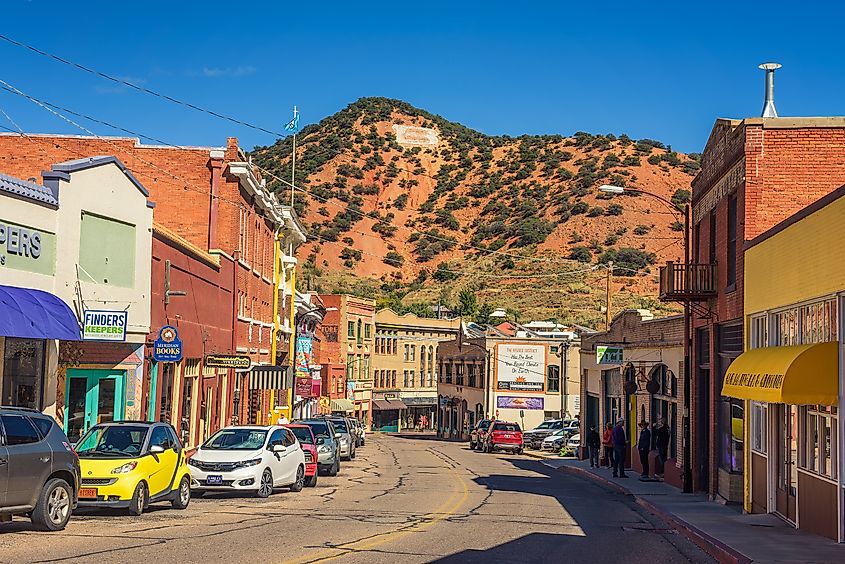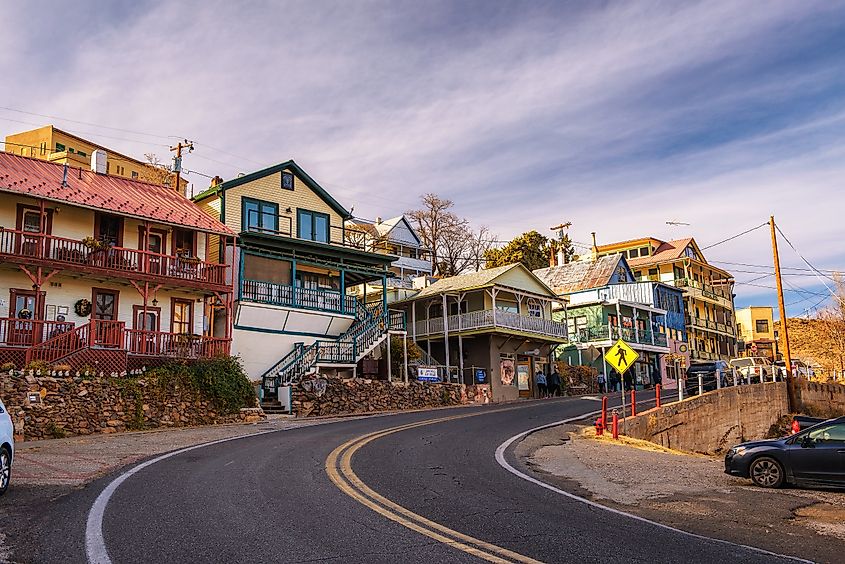
These Historic Towns in Arizona Are Worth Exploring
Arizona's history is the stuff of movies, TV shows, music, and lists like this, which excitedly divulge the state's diverse destinations and their origins. Geological wonders, Indigenous artifacts, Spanish colonial ruins, massive mines, Wild West boomtowns, and artist colonies embody the last billion years of the place that would become known as Arizona, designated as such in 1912. The newest contiguous state has old history ready for new adventures. See the best zones for exploring 'Zona from past to present.
Bisbee

Like many Arizona communities, Bisbee was founded on mining. Unlike other Arizona communities, Bisbee has not buried that history - well, it is literally buried, but the town has plenty of above-ground reminders. There is Copper Queen Hotel, established in 1902 to serve visitors of the eponymous copper mine and now the oldest continuously running hotel in the state. There are the countless cliffside stairs, built during the late 19th, early 20th century mining boom when flat roads made little practical sense. There is also Erie Street, the stylized remnant of a mining town swallowed by Bisbee in the early 1900s.
If you are feeling brave, take the plunge into Bisbee's pit of past prosperity: the aforementioned Queen Mine, which you can tour by train and then train as a prospector. While you cannot enter another discontinued mine, its name, The Lavender Pit, is emblematic of Bisbee's colorful character. When the miners left, artists came. Bisbee has a history of hippiedom almost as deep as its mines.
Tombstone

What is a list of historic Arizona towns without a Wild West entry? Tombstone fills that role about as well as any community in the state - and arguably the country. As the town boomed around silver mining in the 1880s, guns boomed during the most famous shootout in US history when the Earps and Doc Holliday killed three outlaws near (not at) the O.K. Corral. Because of said 140-year-old event, the "city" of 1,300 residents draws almost half a million tourists annually. Most of them visit the rebuilt corral in Tombstone Historic District and enjoy a reenactment of the gunfight. Many also take a tour of supposedly haunted locations, made extra creepy by Boothill Graveyard. What is not creepy about Boothill is its memorials to diverse pioneers, including Chinese, Jews, and Native Americans, the last two of which share a dedicated monument.
Willcox

Willcox, located an hour north of Tombstone and an hour-twenty from Bisbee, was built on transportation and agriculture rather than mining. Established in the 1880s as a hub on the Southern Pacific Railroad, Willcox attracted all manner of people, including Apache leader Geronimo. He allegedly bought sugar in one-pound bags at The Willcox Commercial, a store still in operation. From there, Willcox transitioned into a farming community, producing large quantities of cattle and, more recently, wine. Additionally, it is the birthplace of Western actor Rex Allen and the deathplace of Western participant Warren Earp, the youngest Earp brother, who was killed in a saloon in 1900. His gravesite is a Willcox destination for the macabre historian.
Sedona

Sedona's unique history dates back 280 million years to the formation of giant, red rock buttes. These landmarks, including Cathedral Rock, Capitol Butte, and Bell Rock, are important not only to geology but also to cinema. Back in the Golden Age, Sedona drew filmmakers in need of epic landscapes, particularly for Westerns. Billy The Kid, Broken Arrow, and 3:10 to Yuma are just some of the films made around a town that had 150 residents and still lacked electricity. So many movies were filmed in Sedona that it was dubbed "Little Hollywood."
Like the arid rock that brought it there in the first place, cinema dried up in Sedona, but the town kept hydrated. Today, it is a thriving "city" of nearly 10,000 that attracts millions for the geography and architecture, especially an ingenious mix of both called Chapel of the Holy Cross, a church built into the side of a butte.
Kayenta

Kayenta is a town in the Navajo Nation that was established in 1986. Of course, its history goes back further than that. During WWII, the US military enlisted Navajo people to create code based on their language to bypass enemy surveillance. One of the "code talkers" was the father of the man who operated the first fast-food restaurant in Kayenta. For this reason, when you visit Kayenta Burger King, you will find a code talker museum next to the ketchup dispenser. Go back to 1909, and Kayenta becomes a settlement for Quakers, Mormons, and miners. Mining occurred in the area long before settlement. During Kit Carson's round-up of the Navajo in the 1860s, the ones wearing gold and silver came from this area. Go back millions of years more and the Monument Valley, Kayenta's top historical destination, emerges from the sea. Now you must emerge from your home to see Kayenta.
Tubac

In 1752, following a revolt by the O'odham people against Spanish missionaries, Spain established its first sustained military fort - and thus the first permanent European settlement - in what would become Arizona. Today, that settlement is called Tubac, which preserves just over 1,500 people in the town proper and the ruins of the original fort in Tubac Presidio State Historic Park. Moreover, Tubac proudly displays its post-Spanish history, including artifacts from its time as a Mexican republic and adobe buildings from its time as a New Mexican territory. Even its early American statehood is represented by the Tubac Center of the Arts, built in 1972 to service the numerous artists that have made the community a creative haven since the 1930s. The Tubac Festival of the Arts, in its 65th year, serves the same purpose.
Jerome

Fewer than 500 people live in Jerome, but that makes it easier to explore Cleopatra Hill on which the town sits. Over a billion years old and five thousand feet above sea level, the hill was chosen for its ore deposits, from which valuable minerals were extracted for decades and made Jerome a wealthy boomtown of 10,000. Naturally, the ore ran out and Jerome almost became a ghost town, but it was saved by history and scenery. Now the cliffside community is a veritable museum of subterranean prosperity and open-air hedonism, consisting of a historic mansion, sites of old mines, and even a jail that slid down the slope. Given the narrow, winding roads and switchbacks, driving up Jerome is a treat for the eyes but poison for the nerves.
Arizona's history is downright cinematic, conjuring desert vistas, giant red rock formations, conquistadors, cowboys, outlaws, Native Americans, and prosperous yet dangerous mines. Preserving all that history and more, Bisbee, Tombstone, Willcox, Sedona, Kayenta, Tubac, and Jerome should make you feel like you are in a movie. But do not be misunderstood; what those towns commemorate with tourist-friendly glitz actually happened . . . except maybe for Geronimo and his sweet tooth, although that is the story we like the most.











